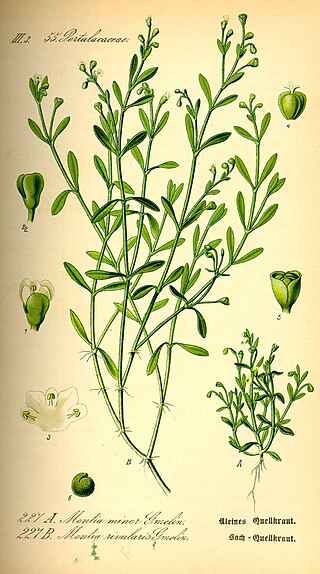
Montia is a genus of plants in the family Montiaceae. Species in this genus are known generally as miner's lettuce or water chickweed. All of the species in the genus have edible leaves. It is found worldwide, except in Asia.

Thelypodium howellii, the Howell's thelypody or Howell's thelypodium, is a rare plant of the Western United States. It is endemic to a relatively small area on the borders of three western States: Oregon, Nevada, and California.

Dimeresia is a monotypic genus in the sunflower family containing the single species Dimeresia howellii, known by the common name doublet.
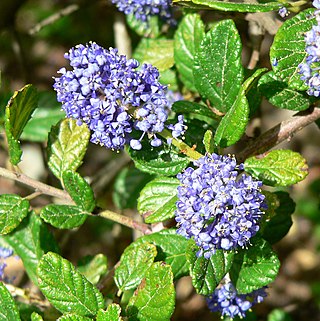
Ceanothus griseus is a species of flowering shrub known by the common names Carmel ceanothus and Carmel creeper. 'Carmel' refers to the Carmel-by-the-Sea region in California.

Allium howellii is a North American species of wild onion known by the common name Howell's onion. It is endemic to California.

Arctostaphylos imbricata is a species of manzanita known by the common name San Bruno Mountain manzanita.
Arnica cernua is a species of arnica known by the common name serpentine arnica. It is native to the Klamath Mountains of northern California and southern Oregon, where it is a member of the serpentine soils flora.
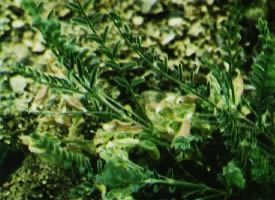
Astragalus johannis-howellii is a species of milkvetch known by the common name Long Valley milkvetch. It is native to eastern California, including Long Valley in Mono County, and its distribution extends over the border into Nevada. It is a plant of the Great Basin's scrub habitat.
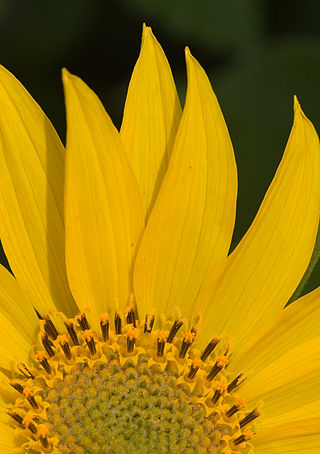
Balsamorhiza deltoidea is a species of flowering plant in the sunflower tribe of the plant family Asteraceae known by the common name deltoid balsamroot. It is native to western North America from British Columbia to California, where it grows in many types of generally mountainous habitat.
Chorizanthe howellii is a species of flowering plant in the buckwheat family known by the common names Mendocino spineflower and Howell's spineflower. It is endemic to coastal Mendocino County, California, where it is known only from the sand dunes and coastal scrub near Fort Bragg. It is estimated that 95% of the remaining individuals of this plant are part of a single population growing at MacKerricher State Park. It is a federally listed endangered species.
Cirsium ciliolatum is a species of thistle known by the common name Ashland thistle. It is endemic to the Klamath Mountains, where it is known from only a few occurrences in Jackson and Josephine Counties in Oregon, as well as neighboring Humboldt and Siskiyou Counties in California. It is related to Cirsium undulatum and may be more accurately described as a variety of that species.
Draba howellii is a species of flowering plant in the family Brassicaceae known by the common names rosette draba and Howell's draba. It is endemic to the Klamath Mountains of northern California and southern Oregon, where it grows in rock crevices. This is a tuft-forming perennial herb, sometimes coated in hairs. Most of the leaves are located at the base of the plant, each oval in shape, up to 2.5 centimeters long, and sometimes edged in fine teeth. There may be one or more leaves on the stem as well. The erect inflorescence bears up to 30 yellow mustardlike flowers. The fruit is an oval silique up to a centimeter long containing several seeds.

Lomatium howellii is an uncommon species of flowering plant in the carrot family known by the common name Howell's biscuitroot, or Howell's lomatium. It is native to the Klamath Mountains of southern Oregon and northern California, where it is a member of the local serpentine soils flora.
Minuartia howellii is an uncommon species of flowering plant in the family Caryophyllaceae known by the common names Howell's stitchwort and Howell's sandwort.

Montia chamissoi is a species of flowering plant in the family Montiaceae known by the common names of water minerslettuce, water montia, Indian lettuce, and toad lily. It is native to much of western North America from Alaska to the southwestern and central United States and also in British Columbia. It grows in moist to wet soils in a variety of habitat types, such as meadows, wetlands, plains, and montanes. It is sometimes aquatic, anchoring in mud and floating in water.

Montia parvifolia is a species of flowering plant in the family Montiaceae known by the common names little-leaf miner's lettuce, small-leaved blinks and small-leaved montia. It is native to western North America from Alaska to California to Montana, where it grows in moist to wet areas in several types of mountain habitat.
Streptanthus howellii is an uncommon species of flowering plant in the mustard family known by the common name Howell's jewelflower. It is endemic to the Klamath Mountains of southern Oregon and northern California. It grows in mountain forests on serpentine soils. It is a perennial herb producing a hairless, often waxy-textured stem up to 70 or 80 centimeters in maximum length. It is generally unbranched. The ephemeral basal leaves have fleshy oval blades with smooth or toothed edges, borne on petioles. Leaves farther up the stem are similar but smaller and narrower, with shorter petioles or none. They do not clasp the stem. Flowers occur at intervals along the upper stem. Each has a calyx of purple sepals under a centimeter long with purple-tipped yellow petals emerging from the tip. The fruit is a thin, smooth, curved silique up to 12 centimeters long.
Stylocline masonii is an uncommon species of flowering plant in the family Asteraceae known by the common name Mason's neststraw.
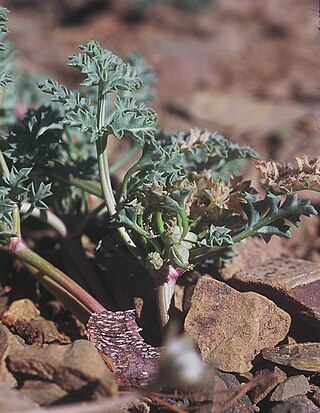
Tauschia howellii is a rare species of flowering plant in the carrot family known by the common names Howell's umbrellawort and Howell's tauschia. It is endemic to the Klamath Mountains of far southern Oregon and far northern California, where it is limited to nine occurrences in the Siskiyou Mountains. It grows in mountain forests on gravelly granite soils, often among stands of Shasta red fir. Despite its rarity it is stable and not considered very endangered. It is a perennial herb growing 30 to 80 centimeters tall. It is hairless in texture. The thick leaves have blades which are divided into leaflets large, sharp teeth and edges curved up, and borne on long petioles. The short inflorescence is a compound umbel of yellow flowers on a few short rays. The fruit is oblong, ribbed, and just a few millimeters long.
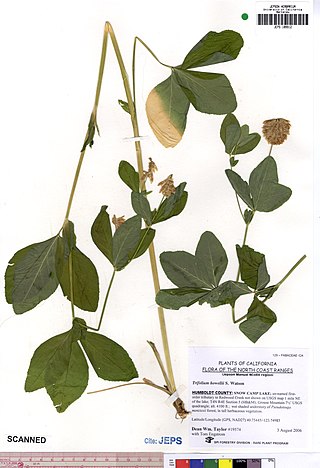
Trifolium howellii is a species of clover known by the common names canyon clover and Howell's clover. It is native to Oregon and California, where it grows in moist and shady habitat types, such as swamps and forest streambanks.














